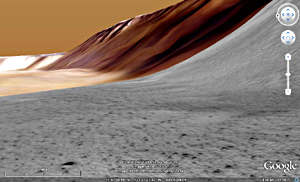 Google Mars view from the slopes of the Olympus Mons caldera. Credit: Google Earth
Google Mars view from the slopes of the Olympus Mons caldera. Credit: Google Earth
I was sitting at my computer the other day, quietly exploring minute details of the surface of planet Mars, when I realized once again that in my lifetime planetary exploration has gone from telescopic-view-only to robotic rovers poking microscopes close up at Martian geology!
Did I say quietly exploring the surface of Mars? Yes I did—and you can, too. First of all, if you're not familiar with Google Earth, please go and google Google Earth and get your free download today (this is NOT a sales pitch!). A modestly powered computer with a decent graphics card is all you need to probe every nook and cranny of planet Earth, sometimes to the detail of spotting people walking in the streets….
But there's a magic button on Google Earth (it looks like planet Saturn, for some reason) that instantly transports you to planet Mars—Google Mars, that is. It's a simple button click to explore Mars, Google Earth style.
This detailed digital Mars has been created with all of the data collected by the fleet of robots we've sent—from Viking to Mars Global Surveyor to Mars Odyssey to Mars Express to Mars Reconnaissance Orbiter (MRO), and of course Pathfinder, Phoenix, and the Mars Exploration Rovers, Spirit and Opportunity.
